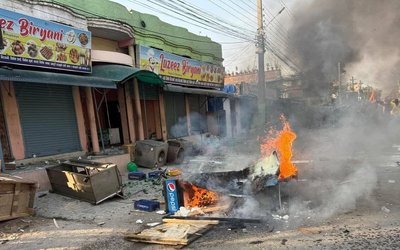
Indian Embassy and B.P. Koirala India-Nepal Foundation in association with Lumbini Bangmaye Pratisthan organized third edition of Culture Nagari in Maha Bouddhi Society, in Lumbini on Tuesday, November 04, 2014.
To promote Nepali art, literature and culture Embassy of India and B.P. Koirala India-Nepal Foundation has been partnering with various local organizations in respective districts to organize programs that promote cultural exchange between India and Nepal even outside Kathmandu, through its initiative "Culture Nagari."
In this edition of Culture Nagari, eminent filmmaker, scriptwriter and critic of India, Shyam Benegal participated as the chief guest. Director Shyam Benegal is also the in-charge of Light and Sound project being constructed in Lumbini under the initiative of Indian Embassy and B.P. Koirala India-Nepal Foundation.
On the occasion, Benegal said, "Lumbini holds a deep historical and cultural value all over the world. It is my honor to be working for this holy birthplace of Lord Buddha. I along with my team are inspecting all the feasibility to complete the project as soon as possible."
The event was chaired by eminent academician of Nepal and former member of Nepal Academy Boond Rana.
28 promising and prominent poets of Nepal recited their poems in various languages such as Nepali, Hindi, English, Urdu, Awadhi, Maithili and Newari.
Abhay Kumar, Head of Press, Information and Culture and Secretary of B.P. Koirala India-Nepal Foundation extended his gratitude to director Shyam Benegal, academician Boond Rana and the members of Lumbini Bangmaye Pratisthan for making the third edition of Culture Nagari, a grand success.
Indian Embassy and B.P. Koirala India-Nepal Foundation organized 18th edition of Voices in a presence of eminent Indian filmmaker, writer and critic Shyam Benegal spoke on “Indian Cinema in Global Context” on this edition of Voices.
Deputy Chief of Mission of Indian Embassy, Piyush Srivastava welcomed Shyam Benegal and shared, “among countless similarities that bring Nepal and India close, cinema has always been one of the major genres that have popularized the Indian art, culture and lifestyle in Nepal. Indian cinema has always benefited a lot from Nepal with a huge population of Nepal following Indian movies since decades. The beauty of Nepal could not keep away veteran actor Dev Anand, therefore, Hare Rama Hare Krishna was largely shot in Nepal. Even the popular Bollywood actor Akshay Kumar recently visited Nepal to shoot his upcoming movie.”
“The history of Indian cinema is much older than a century. It is only the features films that have become 100 years, there were regional movies without sound much before than that,” director Benegal began his talk.
Adding on to the history of Indian cinema, he elaborated, “Technological advancement brought speech in films globally. It was in 1928 when speech was introduced in a film in the world and by 1930, India started experimenting with sounds in films too. As a result, in 1931, Indian film called Alam ara had 36 songs. When India was set independent, the British left some urban characteristics in the urban cities of India. While the rural places of India had their own folk culture to entertain themselves, the urban cities wanted something for their own.”
He added, “British had left their theaters in the urban cities that mostly played British melodramas, which obviously Indian audience could not connect to. Therefore, they chose Naravars model; the nine elements which were present in the classical theater of India to come up with their own theater, with their movies. When Indians started bringing together the nine elements of emotions in a theatrical canvas, they started feeling the aesthetical experience in their own movies.”
Benegal further enunciated how the film culture initially bean in Bengal in 1950s, South India joined the league in 1960s and only in 1970s, the pan India cinema in Hindi language came to fashion through Bombay.
“I believe that Indian cinema of now is actually in a very interesting stage. The young and talented filmmakers like Anurag Kashyap, Diwakar Banerjee and Imtiaz Ali no longer fall prey to limitations in filmmaking and do not event confine themselves into the stereotypical notion of parallel filmmaking,” he highlighted.
Benegal later engaged in interaction with audience discussing on the differences between the commercially successful films and critically acclaimed movies.He concluded, “Popular cinema becomes more like opium. Frankly speaking, popular films are creatively dead.”
Secretary of B.P. Koirala India-Nepal Foundation, Abhay Kumar presented token of appreciation to Shyam Benegal. Earlier, Shyam Benegal had also given a talk to the film students of Oscar College of Film in Kathmandu.
- NEPAL-THAILAND: Joint Business Council
- Apr 13, 2025
- BIMSTEC SUMMIT: Nepal’s Stand
- Apr 11, 2025
- IME GROUP: Expands Into Paper Industry
- Mar 24, 2025
- CPN UML: Instigated By India
- Mar 23, 2025
- ADB’S CHIEF ECONOMIST: Nepal Reduces Poverty
- Mar 11, 2025















